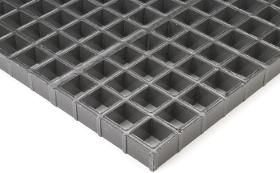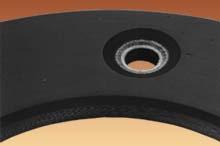- europages
- >
- COMPANIES - SUPPLIERS - SERVICE PROVIDERS
- >
- reinforced glass
Results for
Reinforced glass - Import export

AAAGILER GMBH
Germany
Also available as ATEX-suitable, antistatic, electrically conductive GRP (glass-reinforced plastic) gratings, particularly slip-resistant version (R13). With assembly or cutting to size if required. Suitable for roofs, chemical plants, warehouses, airports, water treatment, electricity, port facilities, railways and shipbuilding. Optionally with installation service.
Request for a quote
POLYNEO GMBH
Germany
PolyNeo GmbH looks back on decades of experience in polymer trading. A high level of professionalism, both customer and supplier contacts that have developed over the years, in-depth market knowledge, strong cost awareness as well as the extensive technical know-how of our employees constitute the strengths of PolyNeo GmbH. For decades now, we have supported producers and customers all over the world by raw material sourcing, marketing and distribution as well as tailor-made logistics services. Raw material and compounds for fibers, film as well as a diversity of extrusion and injection molding applications (mineral filled, glass reinforced, impact modified, UV modified, flame-retardant both halo and non-halo, elevated temperature modified). Broad range of different types e.g. GF 10, GF 15, GF 30, GF 35, GF 40, GF 50
Request for a quote
FEDERAL-MOGUL DEVA GMBH
Germany
Where to use deva.tex ® deva.tex ® is a high performance self-lubricating sliding material with a glass fiber reinforced carrying layer. The machinable sliding layer consists of fibers which are embedded in epoxy resin. The resin carries PTFE as lubricant for excellent tribological performance. deva.tex ® bearings are available up to 1.000 mm and are characterized by a very high corrosion and wear resistance. They are insensitive to contamination as well as to vibrations and shock loads. In addition to standard dimension, special geometries can be machined. Max. possible outer diameter 1.000 mm Applications Water turbines, earth moving equipment, hydromechanical engineering equipment, agricultural machines, railroad applications, shut-off valves, chemical industry and many more. Structure 1. Sliding layer: reinforced polyethylene fibers embedded in epoxy resin and PTFE 2. Glass fiber reinforced carrier
Request for a quote
FEDERAL-MOGUL DEVA GMBH
Germany
Where to use deva.tex ® deva.tex ® is a high performance self-lubricating sliding material with a glass fiber reinforced carrying layer. The machinable sliding layer consists of fibers which are embedded in epoxy resin. The resin carries PTFE as lubricant for excellent tribological performance. deva.tex ® bearings are available up to 1.000 mm and are characterized by a very high corrosion and wear resistance. They are insensitive to contamination as well as to vibrations and shock loads. In addition to standard dimension, special geometries can be machined. Max. possible outer diameter 1.000 mm Applications Water turbines, earth moving equipment, hydromechanical engineering equipment, agricultural machines, railroad applications, shut-off valves, chemical industry and many more. Structure 1. Sliding layer: reinforced polyethylene fibers embedded in epoxy resin and PTFE 2. Glass fiber reinforced carrier
Request for a quote
FEDERAL-MOGUL DEVA GMBH
Germany
Where to use deva.tex ® deva.tex ® is a high performance self-lubricating sliding material with a glass fiber reinforced carrying layer. The machinable sliding layer consists of fibers which are embedded in epoxy resin. The resin carries PTFE as lubricant for excellent tribological performance. deva.tex ® bearings are available up to 1.000 mm and are characterized by a very high corrosion and wear resistance. They are insensitive to contamination as well as to vibrations and shock loads. In addition to standard dimension, special geometries can be machined. Max. possible outer diameter 1.000 mm Applications Water turbines, earth moving equipment, hydromechanical engineering equipment, agricultural machines, railroad applications, shut-off valves, chemical industry and many more. Structure 1. Sliding layer: reinforced polyethylene fibers embedded in epoxy resin and PTFE 2. Glass fiber reinforced carrier
Request for a quoteDo you sell or make similar products?
Sign up to europages and have your products listed

RÜHL FEUERLÖSCHMITTEL GMBH
Germany
GFK Systems PUR Systems Fire Extinguishing Agents Cleaning + Disinfection Infothek About us Contact Products Polyester Foam Resins Polyester Resins Applications Service Quality Newsletter Contact, Glass Fibre Reinforced Plastics Polyester Foam Resins Compared to conventional matrix systems for fibre-reinforced products, UP foam resins offer material and weight reductions of up to 30 % thanks to their micro-cellular foam structure. In simple sealed moulds, glass fibre reinforced plastic components that are smooth on both sides are produced cost-effectively under a vacuum in comparatively short cycle times. The production of sandwich components resistant to bending, with a foam core, and the direct integration of metal reinforcements and threaded elements – for example for large vehicle components – has also proven itself. Typical properties Dense matrix / composite of approximately 0.6–0.7 g/cm³ / 0.7–1.2 g/cm³ Fibre content 20-50% of total weight Moulded part mass per unit area of 3000–5000 g/m² Flexural modulus of elasticity 3000–8000 MPa Bending resistance of 35–185 MPa Impact resistance of 35–65 KJ/m² (with 20–35% glass content) Reinforcing materials: Continuous glass fibre mats Composite glass fibre and fleece mats Natural fibre mats Special formulations and versions Systems with long processing times for very large components Foam resin formulations with elevated dimensional stability under heat Systems for fibre-reinforced components with a high level of characteristics Coordination with gel coat / top coat for surface refinement Flame protection formulations Electrical industry: UL 94 V0 Rail vehicle construction: DIN 5510 (S4, SR1, ST2)
Request for a quote
RÜHL FEUERLÖSCHMITTEL GMBH
Germany
PU composites are mainly found in the production of moulded parts resistant to bending. The skilful combination of materials puts the topic of lightweight construction into the spotlight (honeycomb technology applications). Sophisticated surface designs are supported by corresponding PU / UP resin systems. Thanks to the reduced component weight, moulded part applications are used in the automotive sector – and, with corresponding flame protection formulations, also in rail vehicle construction. Typical properties Moulded part density of 450–1100 kg/m³ Fibre proportion from 30 % Available foaming agents: usually water Reinforcing materials Glass fibre rovings Glass fibre mats and non-crimp glass fibre fabrics Carbon fibres Natural fibres (hemp, sisal, coconut etc.) Special formulations and versions Honeycomb materials for sandwich structure components Paper honeycombs Waterproof paper honeycombs (patent-pending process) Plastic honeycombs Aluminium honeycombs Systems with a large processing window Use of polyols based on renewable resources Self-parting with simultaneous good lamination properties Flame protection formulations Automotive: FMVSS 302 Rail vehicle construction: DIN 5510 (S4, SR2, ST2) Aircraft construction: FAR 25853, ABD 0031 Construction industry: DIN 4102 B2
Request for a quoteResults for
Reinforced glass - Import exportNumber of results
8 ProductsCountries
Company type